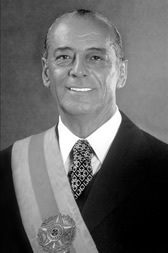The Riocentro case was one of the last attempts made by hard-liners in the army to contain the slow and gradual process of political opening started at the end of the 1970. Dissatisfied with the possibility of the country again having direct representative elections for elected positions, more reactionary groups, and eager to continue from the military control of state institutions, they began to carry out a series of attacks, mainly against leaders and organizations in opposition to the regime. military.

General Figueiredo saw his image frayed with the episode of the Riocentro case
The best known of these attacks took place in Riocentro, on April 30, 1981, in the neighborhood of Jacarepaguá, Rio de Janeiro. The event scheduled for that night was intended to start the Labor Day celebrations, and would have the presence of artists such as Chico Buarque, Alceu Valença, Gonzaguinha and Gal Costa, some of whom stood out in opposition to the military regime, having even returned to the country after the Amnesty Law of 1979.
The attack intended to explode three bombs in the place and with that to incriminate the left groups, making the process of political opening to end. But the military that organized the attack failed to carry out as planned, as one of the bombs exploded in a car in the Riocentro parking lot, killing one sergeant and seriously injuring another official. There was another bomb in the vehicle that did not explode. But a third bomb exploded at the event's power station.
Do not stop now... There's more after the advertising ;)
The case caused enormous strain on the government of General João Batista Figueiredo (1979-1985), who showed that he could not control the forces more to the right of the army, also resulting in the fall of General Golbery do Couto e Silva from the position of Head of the House Civil. Golbery was one of the main articulators of the “slow, gradual and safe” opening process of the dictatorship to the military regime and saw his image weakened by this fact.
The failed attack was a major scandal at the time, which was only overcome by the fact that no real investigations were carried out to discover who were behind the terrorist action. The episode marked the end of the clash between the hardliners and the political opening process.
By Tales Pinto
Graduated in History
Would you like to reference this text in a school or academic work? Look:
PINTO, Tales dos Santos. "The Riocentro case and the end of the Military Dictatorship"; Brazil School. Available in: https://brasilescola.uol.com.br/historiab/o-caso-riocentro-fim-ditadura-militar.htm. Accessed on July 27, 2021.
history of Brazil

Click on this link from Brasil Escola and have access to some information regarding Artur Costa e Silva, second president of the Military Dictatorship. During Costa e Silva's government, the foundations were laid that allowed for the “economic miracle” and, also, began the period of greatest repression of the Dictatorship.
